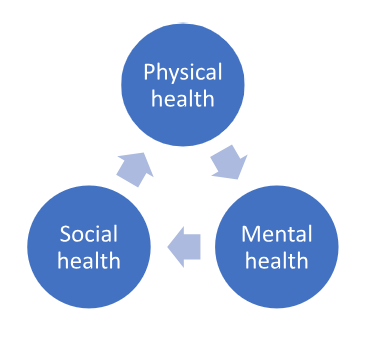Prioritising self-care
Self-care is the cornerstone of resilience and wellbeing. It contributes to practitioners’ wellbeing in two ways: directly, by protecting their health, and indirectly, by helping them manage the emotional demands of the job and avoid burnout. Health and social care practitioners often struggle to prioritise their own wellbeing over meeting the needs of others, typically focusing on the wellbeing of their professional self (i.e. that enables them to support others) rather than their own self-care (Miller et al., 2019). Maintaining good health by using appropriate personal self-care strategies is an essential survival skill, not only to sustain oneself but also to provide the best possible support to people who access services.
Reflecting the three pillars of health, we need strategies to protect our physical, mental and social health.

A self-care plan should also recognise the need to repair, maintain and grow our wellbeing. The following exercise will help you do this.
Repair: The remedial actions we take when we notice signs of stress. Although there are some common symptoms of stress, people can react differently – they may respond emotionally (e.g. become irritable, feel overwhelmed or lose confidence), behaviourally (e.g. become indecisive, isolate themselves from others or turn to alcohol or other substances), or physically (e.g. experience headaches, insomnia or food cravings). Key questions to help you develop repair strategies are:
- Think about a time when you took some action because you noticed symptoms of stress or signs of burnout.
- What signs did you notice and what did you do?
- How effective were your actions?
- What could you do to spot these signs sooner and take pre-emptive action?
Maintenance: Keeping ourselves ‘ticking over’ and operating at full capacity. Key questions to develop your maintenance strategies are:
- What do you do to maintain your wellbeing?
- How successful are these strategies?
- Do you pay enough attention to your physical, mental and social wellbeing?
- What else could you do to maintain your wellbeing across these three areas?
Growth: building the capacity for resilience, to feel and perform at our best. Key questions to develop your growth strategies are:
- What do you do to build your mental and physical resources and invest in your future wellbeing?
- What type of things might destabilise your actions and what could you do to overcome them?
More information can be found here.